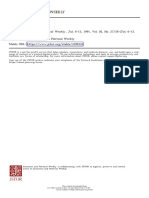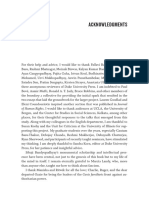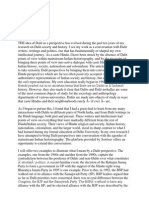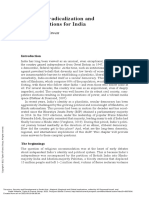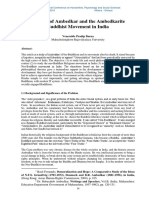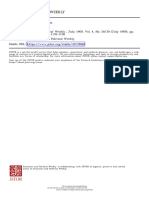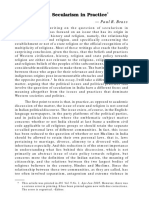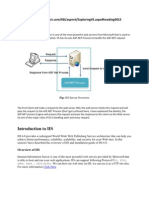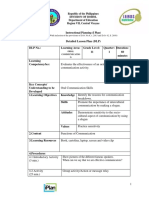Dalit Movements
Uploaded by
btvyshnavibomma1010Dalit Movements
Uploaded by
btvyshnavibomma1010The Political and the Social in the Dalit Movement Today
Author(s): Harish S. Wankhede
Source: Economic and Political Weekly , Feb. 9 - 15, 2008, Vol. 43, No. 6 (Feb. 9 - 15,
2008), pp. 50-57
Published by: Economic and Political Weekly
Stable URL: https://www.jstor.org/stable/40277102
JSTOR is a not-for-profit service that helps scholars, researchers, and students discover, use, and build upon a wide
range of content in a trusted digital archive. We use information technology and tools to increase productivity and
facilitate new forms of scholarship. For more information about JSTOR, please contact support@jstor.org.
Your use of the JSTOR archive indicates your acceptance of the Terms & Conditions of Use, available at
https://about.jstor.org/terms
Economic and Political Weekly is collaborating with JSTOR to digitize, preserve and extend
access to Economic and Political Weekly
This content downloaded from
117.213.64.244 on Sat, 19 Dec 2020 20:32:04 UTC
All use subject to https://about.jstor.org/terms
The Political and the Social in
the Dalit Movement Today
HARISH S WANKHEDE
Post-Am
year
Indiaas on
hav
rise
assertion
The e
era of dé
Uttar
through
dalits
dalits
change i
At th
phenome
hra P
addressin
saheb
tries toco
are s
linke
socio-po
kar's
Uttar Pr
Dalit
Ambedk
demo
Both
elites
nome
ident
Form
alway
move
ness
the id
the s
tural
This
all th
ing t
over
al-sec
are so
mon
on re
The
tive to the mainstream nationalist formulations in all the realms
of public reason. The discourse legitimises the thirst for political
power, as it is one of the prime instruments in bringing a radical
change in social relationships [Sudha Pai 1998: 40]. On the one
hand, rejection of political dominance by the "manuvadis" be-
This is bas
came the mantra of the new dalit political ideology. On the other
Emancipati
hand, the Ambedkarite Buddhist identity challenges the
Jawaharlal
"immoral", unscientific and regressive mode of social system and
Harish Wa
is hopeful of building a modern social order based on human
College, De
values. This alternative conceptualisation of religious identity
** February 9, 2008 B3S9 Economic & Political weekly
This content downloaded from
117.213.64.244 on Sat, 19 Dec 2020 20:32:04 UTC
All use subject to https://about.jstor.org/terms
* = SPECIAL ARTICLE
relates the dalits to a proud passive and lacked
historic legacy any kind
of Buddhism and
them to imagine new cultural symbols He
social system. in convinced
contrast toth
of Hindu
degraded cultural representations. culture, emancipati
[Zelliot
Both the assertion of a new 1996:
political 11-13].
identity andFurthermo
the conve
Buddhist identity become over
essentially important
the question to under
of "separate e
the aspirations of the modern dalit,
strated thatas he
they
wassupplement e
not intereste
well the radical agenda of nomenclature but he was
social transformation. deep
In the p
domain of politics, a dignified presence
identity of people
of his an individual
will beis
ple
tial to exploit the fruits of modern
would democracy.
be the I shall
rights of argu
his comm
the modern Buddhist identity offers
country? this overtly
He was dignityconcern
to the
assertive dalit self without which
ing he/she
of "new willas
dalit" bea identifie
citizen i
wretched, degraded, lower democratic
caste "Hinduorder
self". [Chatterjee 20
Ambedkar formulated and conceptualised
burning questionsthe
of meaning
dalits' pola
political philosophy of both these
clared domainsmodes
two separate with of
cert
st
prerequisite modern ethical norms.
version The contemporary
to Buddhism at Yeola and
movements have followed divergent
first routes
political to
outfit, achieve
The Indep
transformation without behind
any dialogical relationship
formulating bet
such a two
them. This paper will focus on the about
insight reasons of an
India's imaginary
social and po
tance between the two recent transformations: the social up
Secularism:
of dalit castes which embrace BuddhismImportant for Am
to bring social ch
and the assertion of bsp as Ambedkar was a under
a political party modern secular
the leade
of a dalit woman for a dynamic
identity
change
was in
observed
the politics
by Ambed
of Ind
a multi-religious
social science, both this phenomena are often country
studied like
andI
lysed separately. This is analso witnessed the communal
attempt to tensions between the the
examine Hindu andlimitati
Muslim
these movements in forging apolitical elites. If religion as asynthesis
meaningful seer political instrument
out of
friendly dialectics. Sincesucceeds,
both the
it would further social
endanger all theand
minority political
communities. m
Understanding
have the potential of enriching such a drastic
the impact of religion on of
movements democracy,
the a suba
secular polity motives,
masses through their divergent was essentialised by the makers of the Constitution.
experiences and id
Ambedkar
it is imperative to judge them onunderstood
their that under such a conflict-ridden
ethical situation,
credentials.
politically mobilising dalits over the issue of separate religion
Ambedkar and the Dalit Identity
would have a dangerous impact on the secular polity of contem-
porary India.
The underprivileged sections, But he was also convinced
especially, the that Hindu religion as a
"bahujans" an
socialof
"dalits" have had a history mechanism is highly undemocratic,
struggle orthodox and anta-
in challenging "gi
identities and furthermore constructing
gonistic their
to the modern values of citizenship. own
He observed that the altern
identities and political concepts to fulfil
"impure" Hindu identity theforrequiremen
of dalits is responsible their demoral-
contemporary times. In ised
thisand undignified
discoursesocial status. Therefore
"dignitya radical transfor-
of the
mation of society is the
became the outcry for targeting essential so that the social values
nature of and status
then exis
social control. of every individual would supplement the goals of modern
political ideals.
Dalit-bahujan thinkers conceive the nation as a good society w
Conversion tô Buddhism was
its members, considered as individuals or a result of Ambedkar's delibera-
collectivities, respect
another; protect mutual rights
tion over the and
social and show concern
political context and solida
of India in which the
Self-respecters, therefore, felt
dalits that
were one ofas long
the main groups.as there
Ambedkar is the existen
as the chairman
untouchability, all talks of freedom and self-rule is empty.2
of the drafting committee of the constituent assembly visualised
that the future constitution
In the social history of identity of the country would be based
formulation ofon the depr
castes, Ambedkar's name, the
iswestern
the model of citizenship along
most with the secular rights to as he wa
prominent
thinker who successfully the minority communities. Even though
formulated antheassertive
rights of his commu- and sep
nity were formally
dalit identity. He demonstrated that structured
thein the modern constitution, he was
exploitative relation
of the untouchables to the other
aware that theHindus were
implication of constitutional a was
norms result
going to be of the b
very troublesome as the
between two divergent cultures. He Hinduargued
societal attitude went against thethe brah
that
ethics of the constitution. He warned
counter-culture destroyed the great Buddhist civilisation, the constituent assembly w
that if
resulted in the enslavement of the social and economic inequalities
Buddhist remained operational as "unto
population
ables" [baws 1990: 372-374].
in societyHe
then onehad a firm
is doing nothing belief
but "putting our democracy that w
in peril". social transformation is almo
Hinduism any kind of radical
possible. Therefore he argued
On January against
26 we are going to enterthe "reformists"
a life of contradictions. In politics an
"bhakti cult" for their lack we
of social
will have protest
equality and in and
social and economic life we will content
have of
reform. The representation inequality.
of dalits In politics we willin
be recognising
their the principle of one man
discourse was h
Economic & Political weekly IBM February 9, 2008 51
This content downloaded from
117.213.64.244 on Sat, 19 Dec 2020 20:32:04 UTC
All use subject to https://about.jstor.org/terms
SPECIAL ARTICLE :
one vote value. In
aspired ou
to
our social human
and econom
an
one man one value. H
the dalit a
dictions? How shall w
If we dignity
continue to an
deny
democracycapable
in of
peril.3
The post-A
The propagators of
Maharasht
hurdles in the
modelspro
fo
not a and
critique politi
of we
own limitations
from in
each
Ambedkar
therefore a recover
dhism transforma
was suggest
community [Viswa
Dalit-Buddhist Movement in Maharashtra: Limitations
He envisaged that
which would
Many social scientists have developednot
an elusive scholarship overo
future enhance the
the positive impact of Buddhist conversion movement on the
Buddhism for
dalits in Maharashtra. Socially, the dalitsAmb
represent a distinct reli-
tion among dalits
gious identity with new b
forms of rituals, symbols and festivals.
in the They crafted a whole new set of public which
society, culture around the icono-
graphy of Ambedkar and the Buddha by building numerous
Morality as
Buddha Vihars. A aBuddhist
dynamic and popular Comliterature also
Like Machiavelli,
became the part of public consciousness, which represents revo-A
religion lutionary
and songs, plays and realistic autobiographies by dalit
politics
religious order
authors of
and poets [Guru 1997]. Most importantly, it is empha- s
secular political est
sised that the conversion movement has a psychological
between the
dimension two
as it has freed the mahar w
from the sense of inferiority
groups over the
in public [Zelliot 1996: 220]. ma
These illustrations argue that in Ma-
Religion as
harashtra the a precipitates
conversion movement socia a silent social
proud legacy of
and cultural revolution among the dalits. cul
liberty The above-mentioned
to every analysis has a practical validity
ind but it
For the dalits, such
does hot reflect the whole truth. The impact of any movement
sent in Hindu religi
should be measured on all the parameters: social, cultural, eco-
tion. Hisnomic
respect
and political. In Maharashtra, the conversion for
movement
individual liberty
has significantly changed the first three arenas but failed in the
human civilisation.
last, the political domain. The post-Ambedkar political leader-
were enshrined
ship, especially in Maharashtra, failed in asserting themselvesin
as
visualised Buddhis
the true heirs of Ambedkar's socio-political legacy.
doctrine to establ
RPI and Dalit Panthers
"Navayana Buddhis
gap between the
rpi, which was established with ne
a great moral commitment and
under which the
ideology to work for the socially da
and economically disadvan-
Ambedkar injiis
taged sections, including the Buddhists, in a very shortlas
period
lising of time was masses
the grasped by the self-interested mahar leadership.
fo
goals of Theysocial tran
failed to capitalise on the cultural capital created by the
Buddha on October
vibrant dalit movement and mostly worked against its ethos
that he would dedic
[Guru 1997: 21]. The rpi is divided into as many as 11 different
dhism infactions India.
today and the mahar leadership dominâtes
Fur ardently
a political leader
most of these of
factions. The rpi has not only failed in mobilising
cal the backward castes
outfit, the and the Muslims against
Reputhe ruling Con-
cipate ingress but
thealso failed in convincing the non-mahar dalits. Fur-
democ
ples of the politica
thermore, in their desperate move to remain visible in the pow-
reiterated the
er structure they forged tea
opportunistic alliances with the Con-
Ambedkar
gress Party. This societal
made them a "stooge" of the ruling elites and
prime task and
thus a negligible force ther
in Maharashtra's politics. They heralded
any hyperactive
the importance of Buddhist conversion in most of their public p
same principles
meetings but hardly tried to develop a sound synthesis of
and
" February 9, 2008 B223 Economic & Political weekly
This content downloaded from
117.213.64.244 on Sat, 19 Dec 2020 20:32:04 UTC
All use subject to https://about.jstor.org/terms
SPECIAL ARTICLE
mass mobilisation on economic and political problems faced by
created Buddhist identity but overestimated its practical value in
the deprived sections of the state. the politics of Maharashtra. Here they fell short in understanding
In the same period, against the opportunistic and corrupt rpi the dynamics of caste politics in Maharashtra and mistakenly em-
leadership, in 1972 the Dalit Panthers emerged with a radicalployed a monolithic Buddhist category to judge the credentials of
socio-political programme and spiritedly occupied the imagina-
its supporters. The non-mahar dalits refused the leadership of rpi
tions and hopes of young, newly educated dalits [Kuber 2001:and Dalit Panthers because of the impractical and self-centred at-
329-331]. This was an intellectual movement, which succeeded intitude of the mahar leaders. Instead of developing Buddhism as a
establishing new cultural and religious values among the urban
political philosophy they instrumentante it as a political ideology
dalits. But at the peak of its popularity a confrontation brokeand thus alienate many dalit castes and their leaders from rpi
between the two most dynamic leaders of Dalit Panthers,
[Jaffrelot 2006: 390]. The recent upsurge of mass conversion in
Namdeo Dhasal and Raja Dhale, over the primacy of Buddhism
Maharashtra has been used again by the dalit politicians for their
petty political needs without paying attention to the numerous
in the movement of social transformation. The movement split
into two distinct camps with one group (Dhasal) adopting theeconomic and political problems faced by the larger dalit masses
Marxist class perspective and the other (Dhale) adopting the
in the state. The dalit political leadership failed to demonstrate
Ambedkarite Buddhist model for bringing change. The piove-
their willingness to forge a strategic secular alliance with the other
ment also faced the problems of unavailability of infrastructuralnon-Buddhist communities as has been done by Kanshi Ram's bsp
in Uttar Pradesh.
assets, sound political vision and a direct onslaught of militant
Hindutva forces. Due to the divergent ideals of the leadership and
other related problems, the Dalit Panthers died after a half-wonThe BSP and the New Dalit Political Ideology
battle leaving behind a great legacy of vast revolutionary litera-The bsp under the leadership of Kanshi Ram has brought the most
ture and culture [Omvedt 2001]. significant change in the psyche of dalit masses by providing an
In the recent past, the post-Ambedkar Buddhist movement hasumbrella identity, futuristic vision, myths, social ideology and a
had a limited appeal among the dalits and has become a non-
political strategy to become one of the most significant players in
issue in the public discourse. It has constructed a small elite coterie the game of power politics in contemporary India [Kumar 2002:
of dalit intellectuals, bureaucrats and some political leaders who168-69]. The bsp from its very initiation as a political party sym-
bolised the political aspirations of the downtrodden oppressed
monopolise the symbols of Buddhist movements for their person-
masses in India. The name of Kanshi Ram's first political party,
al interest or to criticise the other political elites for their compro-
mising attitude to Ambedkar's legacy. Ambedkar hoped that theDalit Shoshit Sangram Samiti (ds-4), had a broader philosophical
neighbouring Buddhist countries like China, Japan and Southappeal in the fight for the rights of the oppressed and thus reflect-
Korea would help the newly converted dalits in building an inter- ed the unwavering influence of dalit social movement on him.
national Buddhist fraternity, but their help and fraternal relation-Babasaheb Ambedkar also understood that the dalit as a commu-
nity was not only economically exploited, culturally segregated
ships are restricted mostly in building decorative pagodas at
and socially discriminated but also remained untouchable in the
Bodha Gaya and Sarnath in Bihar. One faith based organisation
realm of political power. Therefore he advocated the capture of
(fbo), Trilokya Bouddha Mahasangh Sahayak Gana (tbmsg) is
effectively functioning among the Buddhists, which proposes power
a as one of the main objectives for emancipating the lower
non-political, non-confrontationist but a "spiritual" model tocastes from the elite domination [Jaffrelot 2006: 423]. As early as
in 1932 at the All India Depressed Classes Congress at Nagpur, he
propagate Buddhism. Some of the new enthusiasts who have
proclaimed his wish to establish dalits as a ruling class in India.
joined the Buddhist movement possess questionable public
credentials because of their non-social outlook. The non-dalit It is very necessary that the political reins should come in the hands
Buddhist organisations like Bouddha Mahasabha of Kolkata is of untouchables. For that, all of us should unite and secure a political
so insensitive to the Ambedkarite Buddhist movement that it status. Untouchability in India will not be eradicated so long as the
untouchables do not control the political strings.6
does not even mention Ambedkar's religious conversion as an
important landmark in their souvenir on 2,500 years of In the post-Ambedkar era, Kanshi Ram became the true torch-
Buddhism in India. Such insensitivity is also visible in thebearer of Ambedkarite struggle in the political arena of India. He
materialised this vision by giving a practical road map of social
Mahaboudhi temple of Bouddha Gaya, where even after a 10 year
long struggle by Bhadant Surei Sasai, most of the monks arerevolution based on the idea of social engineering. The political
brahmins and not Buddhists [Lokhande 2005]. "bahujan" was one of the most imaginative political categories,
which Kanshi Ram coined to overturn the dominant generalisa-
The dalit-Buddhist movement in Maharashtra has failed in gen-
erating a dynamic cultural assertion, which can encompass the tion that the deprived classes are always submissive bearers of
aspirations of all the oppressed sections. These movements over-political power. The bahujan identity also rejects the mainstream
formulations based on class, religion and secularism because
estimated the values of ideological commitments and failed drasti-
they favour and legitimise the control of upper castes over the
cally in the arena of politics. The attempt to bring socio-
religious change for the dalits in a constitutionally secular but cul- rest. The political philosophies of social elites disregard the aspi-
turally communal atmosphere through political mobilisation hadrations of dalits and lack any radical programme to bring about
a moral imperative but as a political strategy was disastrous. Thesocial transformation. Challenging the limitations of these na-
tional parties, the bsp argues that an inclusive and representative
rpi and Dalit Panthers tried to utilise the aspirations of the newly
Economic & Political weekly QSQ February 9, 2008 53
This content downloaded from
117.213.64.244 on Sat, 19 Dec 2020 20:32:04 UTC
All use subject to https://about.jstor.org/terms
SPECIAL ARTICLE
consistent idea of "social engineering" between the deprived
social engineering of castes and minorities is the most appro-
priate formula for power sharing. sections of the country. In its recent 'avatar', the bsp is riding the
chariot of power with the help of a community, which is notori-
Democratic Political Alliance
ously condemned in history by the ideologues and thinkers of
This alternative conceptualisation of a political party based on a for its shrewdness, greed of power and criminal valori-
bahujans
majority-minority dichotomy mirrors the classical Marxist cate-
sation of their social status. Keeping such a partner in power can
gory but with new cultural attires suitable to the Indiancompel
context.
the bsp to dilute the vital issues of social justice, law and
Social identity not only replaces the class category in this mode
order and secularism. Secondly, there is a threat that due to its
but also democratises the whole structure by sanctioning the on power, the bsp will forget the ethical idea of empow-
fixation
autonomy to every cultural, social and religious groupering
before
the "bahujans". In the thirst of capturing "sarvajan", there
forming the alliance. The bahujan identity neither believes
is ainpossibility
the of compromise in delivering social justice to the
total submission of all deprived communitarian identitiesbahujan
to be- masses. Such openness to the non-bahujans can also
come one nor does it philosophise a complete suppression of the the moral guidelines of the movements and offer an
undermine
opportunity
minority ruling elites to achieve its political ideals. Bahujan iden- to the manuwadis to gradually consolidate their
tity is a democratic political alliance between the politically de-
domination under the garb of sarvajan [Guru 2003: 26]. The bsp
prived caste groups of contemporary India under the leadership
must remain committed to forge an unbreakable unity of all the
of the most exploited castes of Indian history, the dalits. deprived
This coa- sections of the society.
lition of all deprived minority communities (scheduled castes,
Furthermore, such grand emphasis on the instrumentality of
scheduled tribes, other backward castes, and minorities) political
in prac- power in bringing about social change underestimates
tical sense represents the majority of the population in
theIndia
control of social and cultural mafias in their respective
[Hasan 2004: 382]. The bsp mobilises its voters using this newly
fields. It will be a mistake by the bsp to think that hierarchical
social
carved meta-narrative by making one grand promise that powerrelations based on sanctioned religiosity can be over-
is the "guru-killi" or master key which enables its wielders
hauled to
through the employment of power [Rodriguez 2006]. bsp
open every lock, whether social, political, economic or thus
cultural
underestimates the values of social movements in fighting
[Dubey 2001: 228-310]. these ills at the ground level, especially of the Buddhist
The dalits being the formulators and leaders of the social
bahujanmovement. Even Ambedkar had warned the deprived
sections
category are also the most stringent advocators of the bsp's politi- not to solely depend on political power for their
cal strategies. They have discovered a pan-national legacy of
emancipation.
"bahujan leaders" as their ideologues and constructed a distinct
Those who depend upon these political safeguards must think as to
political discourse based on Ambedkar's thoughts. Being dalits,
what will happen after these safeguards are withdrawn. On the day
they endeavour to overthrow the social, political, cultural
on arid
which our political rights cease to exist, we will have to depend
economic dominations perpetuated by the Hindu social order.
upon our social strength. I have already told you that this social
strength is wanting in us. So also I have proved in the beginning that
Such a revolutionary appeal is the basic component of this vanguard
this strength cannot be achieved without the conversion. None should
party to bring real social change in India and therefore, "dalitness"
think of the present only. To forget what is eternally beneficial and
becomes the core value of bahujan political philosophy. to be allured by temporary gains is bound to lead to suffering. Under
The bsp's magnificent victory in the recent Uttar Pradesh elec-
these circumstances, one must think of what is permanently benefi-
cial.pro-
tions has shown that they are second to no political outfit in In my opinion, conversion is the only way to eternal bliss. Nobody
should
viding political leadership to all those people who want a greathesitate even if the political rights are required to be sacrificed
for this purpose.7
and inclusive democracy, corruption-free society and state sys-
tem based on strict observance of law and constitutional norms.
This victory has a capacity to generate a revolutionary Tenets
spirit of
in Social Movements
the whole democratic system for a required change. The
Political
social movements of India's deprived castes are based on
power in India is controlled and instrumentalised by the upper
three major tenets: firstly, the social movement identifies the
caste ruling elites for the benefits of a small and exclusive group
basis of exploitation by identifying two categories, namely, the
of people and has persistently denied the bahujans from exploiter
its valid and the exploited subjects. In India, caste categories
share. Mayawati has shown the way that the dalits as thebased
leaders
on "pure and impure" births become the base for such cate-
of the people can discover new political arithmetic between the
gorisation. Secondly, in the struggle against oppressive social
social groups and can mobilise them towards a concretesystem,
politicalthe movement challenges the domination of the op-
victory. This is indeed a real social revolution under the pressed
proletar-
in all the arenas of civilisation. Periyar challenged the
iat dalit leadership in a most democratic manner, withouthegemony
spilling of brahmins in the social, political, cultural and reli-
a drop of blood. gious order and forged a plan for complete destruction of the
brahmanical system. Thirdly, the social movement imagines the
Limitations of BSP as a Social Movement
alternative model for a better society. Ambedkar prioritised a
But there are some cautious warnings too along with such warm which would be based on the values of liberty, equality and
society,
analysis. The political power seizure by bsp has introduced the
fraternity, against the cherished varnashrama dharma of Gandhi.
party in public with a new political ideology different from
Thus,the
a self-conscious dignified social identity, a commitment to
"^ CA
"^ February 9, 2008 CDE3
This content downloaded from
117.213.64.244 on Sat, 19 Dec 2020 20:32:04 UTC
All use subject to https://about.jstor.org/terms
SPECIAL ARTICLE
end the oppressive social order and a hope for the establishment identities. He was also convinced that Buddhism provides a
of an equal and libertarian society, become the basic tenets of thecomprehensive socio-political and cultural alternative, which
social movements in India. is conducive to an effective functioning of the democratic
To fulfil the agenda of dalit emancipation, a relentless strugglepolity. Secondly, in the social domain, Ambedkar assumed that
with a non-compromising commitment to the ideology of social conversion, as a conscious apparatus of subaltern masses will
emancipation should always be prioritised in the movement, bsp bring radical changes in the socio-cultural relationships of Indian
as a social movement initiated its public activism as a crusadersociety. Buddhism, at the first stage, would de-caste the dalits
against social and political maladies, which under the strategicfrom their primordial caste identity and in the progressive run to
political compulsion transformed its ethical imperatives into "establish the kingdom of righteousness" would counter the
bourgeois political tactics, bsp's new mantra acknowledges theorthodox religiosity of Hinduism. In the battle between the sci-
credentials of every group, not according to its social location butentific temperament of Buddhism and the irrational doctrine of
according to its political representation. Under this considerationbrahmanism, the destruction of Hinduism is inevitable. Thus,
they have located that the brahmin and baniya castes are mar-Ambedkar's conversion movement idealised a peaceful function-
ginally represented in the political map of up and therefore it be-ing of social transformation along with the progress of the mod-
came their sole credentials to be the part of the social movementern nation state.
led by the bsp. This alliance défies the first core principles on
which a democratic social movement of India's proletariat should Limits of Nominal Instrumentality
have emerged. The contemporary subaltern politics throughout the country has
Furthermore, a consistent onslaught on the caste system isemployed caste as an ideological benchmark for political mobili-
needed for its total transformation. Dalits are the worst affectedsations, in forging alliances and in the end to capture state power.
sections because of the perpetual social discrimination existingThe politics of caste challenges the domination of one group of
in the society. This is also the community whose committed sup- castes to exchange it with the other and thus establishes the
port enabled the bsp to play in the corridors of power. The bsp primacy of caste identity in the public discourse. Caste identity
should take keen interest in the emancipation of the dalit masseswhen operating in public, does so with a grand baggage of a
by fighting all kinds of social evils and work to radicalise the soci- social, cultural and historic past. If the bearers of this baggage do
ety towards an inclusive and fraternal social order. not have an equal status, sense of fraternity and moral courage,
then those who occupy the positions of superior social status will
Social and Political Agenda of Dalits dominate them. Thus, such nominal instrumentality can replace
A separate analysis of these movements demonstrates that both the political elites but it does not have the capability to bring
of them at their respective spaces are unconsciously prioritising about social and cultural equality in the society. Brahmanism as
two distinct alternatives for bringing social change. There is lack a social ideology will remain functional if the caste identities are
of respect vis-à-vis each other's strategies and many times these operating in public with the notion of purity and impurity, bsp,
movements are critical and antagonistic to each other. On oneunder the leadership of dalits, is controlling the apparatus of state
hand the Buddhist movement in Maharashtra cunningly valour- power and has succeeded in replacing one set of political elites.
ises its cultural and psychological impact on the mahars but failsThe real struggle of bsp furthermore lies in transforming the
to provide any kind of political alternative to the vast deprived social, cultural and economic status of the dalits.
non-Buddhist communities. It is unsuccessful in aggregating the The dalit masses respect the political churning of bsp as an in-
interest of the deprived sections. On the other hand, in Uttartegral part of a large social movement. They believe that the con-
Pradesh, the bsp succeeded in providing a dalit leadership to atrollers of political power have the legitimate authority to bring
multi-caste, multi-religious political alliance, but lacks in provid-revolutionary changes in society, bsp using this metaphor mobi-
ing an empowered social milieu for the dalits. The politicallises the dalit masses for its support. Moreover to capture power
socialisation of dalits has a limited impact on their present social, it forms tactical alliances with other caste groups, which tradi-
cultural and economic status. A vast majority of dalits in Uttartionally are against the whole ethos of dalit assertion. Such grand
Pradesh are prone to the ills of untouchability, poverty and illit- alliances, once they come to power, will not be under the author-
eracy and a symbolic dalit political leadership is facing limita-ity of one caste group but will be under the scrutiny of many ad-
tions in fighting these evils through the corridors of power. Bothditional power blocs with a capacity of bargain. For Mayawati,
the movements further provide sound references to Ambedkar'sthe chief minister, bringing social change in this political situa-
political and social writings to legitimise their claim as right tion will be a tough task. Even if she succeeds in bringing a con-
and perfect. sensus for any of her radical policy, it will be difficult for her to
Ambedkar had employed Buddhism in the society, by giving implement it in a society, which is ridden by regressive, conser-
an insight to the larger political context and its moral purpose vative and orthodox social practices, including untouchability.
in the modern world [baws 1990]. He was convinced that Thus, political power will face a strong challenge from "civil
Buddhism possessed a moral doctrine with two major objectives society" in its pursuit of establishing an ideal social order. The
to perform. Firstly, in the political domain, it will be helpful for recent uproar of the upper caste elites over the 27 per cent reser-
the dalits in creating a non-communal political ideology and vation for the obcs in central educational institutions is an
identity against other existing perspectives of violent political eye-opener about the society in which we are living.
Economic & Political weekly ESSS3 February 9, 2008 55
This content downloaded from
117.213.64.244 on Sat, 19 Dec 2020 20:32:04 UTC
All use subject to https://about.jstor.org/terms
SPECIAL ARTICLE = ■ • =
Social, economic and
movements to articulate and aggregate genuine demands of pub- po
public lic interest to the modern state.
paradigms. In a de
other to produce consisten
the Ambedkarite Dynamics
traditional societal valu
state is at Ambedkar was well aware
the about these contradictions between
forefront
society. The
the virtues interest agg
of modernity and the explicit autonomy of conserv-
usually asserted and
ative values persisting in society. Therefore he proposed two dem
organisations
dynamic strategiesand mass
to counter this challenge. A religious conver- m
within sion movement willis
society challenge the hegemony of the social
the firstelites,
state to by establishing a secular fraternity. Secondly inthe
understand the pursuit to n
as an outsider, only
control political power, the dalits will forge an alliance prom
with the
every individual
other marginalised sections and should
if they succeed, this will estab- ge
her lish the order
situation in of social justice.
the Only a fraternal social
larger system is
But in contrast,
conducive to bear the fruits of social justice.when
"good" over Democracy
the is quite different public
from republic as well as from parliamen- wit
faces fierce taryopposition
government. The roots of democracy lie not in form of govern- fr
social sciences, many
ment, parliamentary or otherwise. A democracy is more than a form sc
rubric of of government. A democracy is a mode of associated versu
"tradition living. The roots
of democracy are to be searched in social relationship, in terms of as-
propose is an important o
sociated life between the people who form the society.9
alien standards on the in
growing The Buddhist conversion movement as a substitute to Hindus'
intolerance and
2006]. The social
modern natio
hierarchy argues for the annihilation of the caste-based
moral constitutional
social system and upholds an ideology based on social justice sys
and
change, curtailing
equal opportunities. It represents a new moral self the
for the indi- d
nants of past civilisation
vidual citizen in public to claim the benefits of liberal democracy.
the Indian Itcontext. First
constructs a positive collective culture of people based on a
commitment of
fraternal and rational ethos the
and finally it symbolises a vision for st
underestimate the control of conservatism over the societal the reconstruction of society by bringing the issue of "social
order. Secondly, they are neglecting the limitations of demo- democracy" into the mainstream debates of political develop-
cratic polity in bringing radical social change, and thirdly, they ment. The conversion movement further aspired to change the
undermine the capacity and capability of progressive social discourse from "politics of caste" to a moral domain of "public
Economic&PoliticalwEEKLY
MONEY, BANKING AND FINANCE
March 31, 2007
Global Imbalances, Reserve Management and Public Infrastructure in India -Avinash D Persaud
Banking Reforms in India: Charting a Unique Course -TTRam Mohan
Inclusive Financial Systems: Some Design Principles and a Case Study -Nachiket Mor, Bindu Ananth
Microfinance Development Strategy for India -Anil K Khandelwal
Private Equity: A New Role for Finance? -C P Chandrasekhar
Hedge Funds -A V Rajwade
Commodity Derivatives Market
Commodity Futures in India -Kamal Nayan Kabra
The Microcredit Alternative? -Madhura Swaminathan
Consumer Protection in Indian Microfinance: Lessons from Andhra Pradesh and the Microfinance Bill -Probhu Ghate
A Microfinance Institution with a Difference -Aloysius P Fernandez
Microfinance for Poverty Reduction: The Kalanjiam Way -M P Vasimalai, K Narender
Banking and Financial Policy: An Independent View -Rajaram Dasgupta, M Thomas Paul
How Do We Assess Monetary Policy Stance? Characterisation of a Narrative Monetary Measure for India -Indranil Bhattacharyya, Partha Ra
Indian Banks' Diminishing Appetite for Government Securities: A Change of Diet? -Amadou Sy
Indian Macroeconomic Concerns: Corrective Steps towards Sound Banking -Rupa Rege Nitsure
For copies write to: Circulation Manager,
Economic and Political Weekly, Hitkari House, 6th Floor, 284, Shahid Bhagatsingh Road, Mumbai 400 001.
5 February 9, 2008 EQ59 Economic & Political weekly
This content downloaded from
117.213.64.244 on Sat, 19 Dec 2020 20:32:04 UTC
All use subject to https://about.jstor.org/terms
- SPECIAL ARTICLE
religion". It critically diminished the primacy of caste in main- under the larger consensus on political democracy. Modern de-
stream discourse with a secular perspective, and necessitates mocracy in India therfore reflects the following three important
a need of a moral religion in the public domain. In the recent characteristics concerning the nature of dalit politics. First, it has
history of the dalit movement such grand idealisations of the a blurred,.narrow and a power-centric perspective having limited
Buddhist movement were compromised, ridiculed and even chal- effects on socio, cultural and economic status of the community.
lenged in some quarters. In Maharashtra only the mahar and Secondly, being the representative of particular caste/castes in
mang castes among the dalits have somehow succeeded in mak- politics it operates in the circle of hierarchal relationships without
ing a concrete sense of the Buddhist conversion movement in the actually breaking the permanent pure-impure dichotomy. Finally, it
recent past, but have left many other dalit castes out of this pur- upholds a strict and non-compromising attitude over the issues of
view. This success is nominal as it has failed to carry forward this leadership and over the question of participation in the broader
movement in other parts of the country but it does not mean that struggles of social- change. The characteristics presented here are
the cherished moral and ethical values have met a sorry end. the reflections of a fundamentally caste-ordained political psycho-
logy of dalit politics, which has failed to articulate another di-
Conclusions
mension of Ambedkar's vision based on the philosophy of Buddhist
The post-Ambedkar dalit movements by not giving the conversion
needed movement. This religious movement lacks dynamism
importance to the socio-political and cultural notions of Buddhism
to become a political movement of the whole deprived classes, but it
carries the potential ingredients to challenge the social control of
have developed a strategy that is limited to the issues of political
democracy. They aggregate the issue of representation brahmanical
of the elites. This is an appropriate time for the intellectuals
of the dalit-bahujan masses to deliberate on these issues in order
identity as the main agenda and neglect the struggle of alienation
of caste system. Thus, the agenda of social democracy is sidelined
to develop a better synthesis out of this imaginary dialectics.
notes ^^_ Bhau, Lokhande (2005
Rymlicka, Wil
Surai Sasai', Aaj
TheorykaofSure
Min
l thanMoreone millio
edition, Nagpur.
Madan, T N
bai on May 27, 2007, w
Chatterjee, OUP,
Partha New
(2006D
braced the Buddhist re
Permanent Black,
Mahajan, New
Gur
Delhi, One Lakh People
-
Kendrapara
(2006a): 'Dr
in ford
Ambedka
Univers
Orissa on
Citizenship*
converted to in V
Michaels,
BuddhismR Ax
M
version,(eds), Political
Frontline, Orient Ideas June Long in
Exploration, Omvedt, PHISPC (V
Gai
2 Valerian Rodriguez,
Modern tions, New
India' NewinDelhi.Delhi. V R M
(eds), Copley,
PoliticalAntony
- (2001) : 'Ambedkar
Ideas (1999):
and After: The Dalit Movement in
University
Exploration, in India' Press,
PHISPC New
in Ghanshyam Shah (ed), Dalit Identity (Vo
tions, Dallmayr,
New Fred
Delhi, and
and Politics, Sage Publications, New Delhi.
2006. G N
and Modernity, Sage Pu
3 'Constituent - (2003): Buddhism in India, Sage Publications,
Assembly
port, Davis,Delhi,
New Brian New Delhi. (2000): 1989, Ph
University Press,
Parekh, Bhikhu Lond
(2006): Rethinking Multiculturalism,
4 Ambedkar himself ca
Dubey,from
distinction Abhay Palgrave, New York. Kumarthe th(2
dhism: er Player:
Hinyana, A Study
Rawls, John (1971): Theory of Justice,Maha
Harvard Univer- of K
aspect
Shah
is
(ed),
illustrated
Dalit
sity Press, Massachusetts. Identit in l
cations, New Delhi.
dhism in India, - (1993): PoliticalSage
Liberalism, Columbia University Pu
5 See Dumont,
the Louis
Constitutio
Press, New York. (2006)
Sabha,University
Independent
Robinson, DavePress, New L
(2005): Introducing Ethics, Totem
Scheduled
Guru, Castes
Gopal
Books, London. Feder
(1997): Dalit
BAWS, Politics
Vol 17in
Rabinow, PaulMaharashtr
(Part Two
(1994): Michel Foucault: Ethics, Essen-
ment ofMumbai.
Maharashtra, M
tial Works of Foucault 1954-1984, Penguin Books,
6 B R Ambedkar,
- (ed) (2003): London, Atrophy Unt in
cal Rendra,
Power in Mumbai,
Hari
Rodriguez, Valerian (2002): The EssentialNark
Writings of 2005
Three), Education
Hasan, Zoya (ed)
B R Ambedkar, Oxford Dep
(2000)
University Press, New Delhi.
rashtra, Mumbai,
Sage Publications, 2003,
- (2006): 'Dalit-Bahujan Discourse in Modern India' New
7, Ibid, p 143. - (2004): 'Representat
in V R Mehta and Thomas Panthan (eds), Political
8 Ashish Nandy, T N Madan and Partha Chatterjee New Lower
Ideas in Modern Caste
India: Thematic Exploration, PHIS- Polit
are three important critiques of western moder- Hasan (ed),
PC (Vol X, Part 7) Parties
, Sage Publications, New Delhi. an
nity in the recent times. They have developed OUP, New
Sen, AmartyaDelhi.
(2005): Inequality Re-examined, Oxford
an academic debate over the relationship of Jaffrelot, Christoph
University Press, New York.
modernity and indigenous civilisation in the post- Shah, Ghanshyam (ed) (2003): Dalits and thePerman
Untouchability, State,
colonial India. CBC, New Delhi.
- (2006): India's Silent
9 B R Ambedkar, Prospects of Democracy in India, Black, New Delhi.
Smith, B L (ed) (1978): Social and Religious Conflict in
in Hari Narke (ed), BAWS, Vol 17 (Part Three), South Asia, University of Chicago Press.
Jenkins, Laura Dudley (
Education Dept, government of Maharashtra, tion in Srinivas, M N (ed) (1996): Caste:Routledg
India, Its Twentieth Century
Mumbai, 2003^519. Avatar, Penguin Books.
Joseph, Sarah (2006): 'M
Mehta Sudha, Pai (1998):
and 'The BSP in Uttar Pradesh',
V
Thomas Semi-
R
Modern nar, November. India: in Them
REFERENCES (Vol X, Part 7),
Turner, Bryan S: Religion Sage
and Social Theory, Hein- Pub
Aloysius, G (1997): Madhu
Rishwar, emann Educational Books, London.
Nationalism (1998):w
India, tionalism,
Oxford Vishwanathan,
University OUP, Gauri (2001): OutsidePress,
the Fold,
New OUP, D
N
Austin, Rotani,
Granville H New
(1966): Delhi.
(ed) (1997):
The C
Ind
Cornerstoneandofthe
a Depressed,
Young, Marion Iris (1990): Justice
Nation, OUP. and Politics of Man
Bom
Babasaheb Ruber, W Difference,
Ambedkar: N Princeton (2001): Writin
University Press, New Jersey. Am
(BAWS). ple's
Vasant Zelliot, Eleanor (1996): From Untouchable
Publishing
Moon and to Dalit,
House Har
Vols 3, 7,Rumar,
8 and 17 Essays
Vivek
(Part on Ambedkar Movement,
(2002): Manohar
Three), Da
government of Publishers, Delhi. New
Publications,
Maharashtra, DelhMum
Economic & Political weekly Q3S3 February 9, 2008 57
This content downloaded from
117.213.64.244 on Sat, 19 Dec 2020 20:32:04 UTC
All use subject to https://about.jstor.org/terms
You might also like
- This Content Downloaded From 14.139.215.242 On Thu, 09 Jul 2020 10:58:58 UTCNo ratings yetThis Content Downloaded From 14.139.215.242 On Thu, 09 Jul 2020 10:58:58 UTC17 pages
- VERMA ReinterpretingBuddhismAmbedkar 2010No ratings yetVERMA ReinterpretingBuddhismAmbedkar 201011 pages
- Gandhi's Hinduism and Savarkar's HindutvaNo ratings yetGandhi's Hinduism and Savarkar's Hindutva7 pages
- Reinterpreting Buddhism: Ambedkar On The Politics of Social ActionNo ratings yetReinterpreting Buddhism: Ambedkar On The Politics of Social Action10 pages
- Anustup Basu - Hindutva As Political Monotheism-Duke Univ PR (2020)No ratings yetAnustup Basu - Hindutva As Political Monotheism-Duke Univ PR (2020)284 pages
- Communalism in Indian Politics (Rajni Kothari)No ratings yetCommunalism in Indian Politics (Rajni Kothari)226 pages
- India's Social and Political Landscape Is Deeply Influenced by Its Religiou - 20241113 - 115411 - 0000No ratings yetIndia's Social and Political Landscape Is Deeply Influenced by Its Religiou - 20241113 - 115411 - 000010 pages
- India Is Not A Pluralist Democracy (1) - 1No ratings yetIndia Is Not A Pluralist Democracy (1) - 14 pages
- The Secular State and Religious Conflict: Liberal Neutrality and The Indian Case of PluralismNo ratings yetThe Secular State and Religious Conflict: Liberal Neutrality and The Indian Case of Pluralism26 pages
- A Review of Dr. B R Ambedkar's Social IdeologyNo ratings yetA Review of Dr. B R Ambedkar's Social Ideology11 pages
- Political Hinduism The Religious Imagination in Public Spheres (Vinay Lal (Ed) ) (Z-Library)No ratings yetPolitical Hinduism The Religious Imagination in Public Spheres (Vinay Lal (Ed) ) (Z-Library)298 pages
- Sudha Pai - Dalit Assertion and The Unfinished Democratic Revolution - The Bahujan Samaj Party in Uttar Pradesh-Sage Publications (2002)No ratings yetSudha Pai - Dalit Assertion and The Unfinished Democratic Revolution - The Bahujan Samaj Party in Uttar Pradesh-Sage Publications (2002)280 pages
- Dalit Christians and Identity Politics in IndiaNo ratings yetDalit Christians and Identity Politics in India9 pages
- Nandy TwilightCertitudesSecularism 1997No ratings yetNandy TwilightCertitudesSecularism 199721 pages
- Ayodhya and Politics of India's SecularismNo ratings yetAyodhya and Politics of India's Secularism21 pages
- Dalit Encounters With Casteism in Different Historical ContextsNo ratings yetDalit Encounters With Casteism in Different Historical Contexts5 pages
- Stormy Tides of Saffron Wave Rise of Hindutva in The 21st CenturyNo ratings yetStormy Tides of Saffron Wave Rise of Hindutva in The 21st Century6 pages
- Dalit Movements in History Of. 2nd Semester of BallbNo ratings yetDalit Movements in History Of. 2nd Semester of Ballb3 pages
- OceanofPDF - Com Soul and Sword - Hindol SenguptaNo ratings yetOceanofPDF - Com Soul and Sword - Hindol Sengupta221 pages
- Anthropology and The Indigenous Slot Claims To ANo ratings yetAnthropology and The Indigenous Slot Claims To A23 pages
- Covidien Bed SIde Spo2 Monitoring SystemNo ratings yetCovidien Bed SIde Spo2 Monitoring System2 pages
- Understanding Solar Plant Design ParametersSolar Irradiance, Tilt Angle, Azimuth, Efficiency Factors and Shading AnalysisNo ratings yetUnderstanding Solar Plant Design ParametersSolar Irradiance, Tilt Angle, Azimuth, Efficiency Factors and Shading Analysis46 pages
- Republic of The Philippines Division of Bohol Department of Education Region VII, Central VisayasNo ratings yetRepublic of The Philippines Division of Bohol Department of Education Region VII, Central Visayas6 pages
- Lily (1) The Differences Between News On TV and News in MagazinesNo ratings yetLily (1) The Differences Between News On TV and News in Magazines2 pages
- Gold Standard Benchmark For Cisco IOS Routers. Gold Standard Benchmark Version 3.0.1No ratings yetGold Standard Benchmark For Cisco IOS Routers. Gold Standard Benchmark Version 3.0.137 pages
- Disks - RouterOS - MikroTik DocumentationNo ratings yetDisks - RouterOS - MikroTik Documentation1 page
- Part - A Answer The Following Questions (10x1 10)No ratings yetPart - A Answer The Following Questions (10x1 10)2 pages
- European Commission. (2013, November) - Organic Versus Conventional FarmingNo ratings yetEuropean Commission. (2013, November) - Organic Versus Conventional Farming10 pages
- Differences Between The NPV Vs IRR Vs PB Vs PI Vs ARRNo ratings yetDifferences Between The NPV Vs IRR Vs PB Vs PI Vs ARR4 pages














